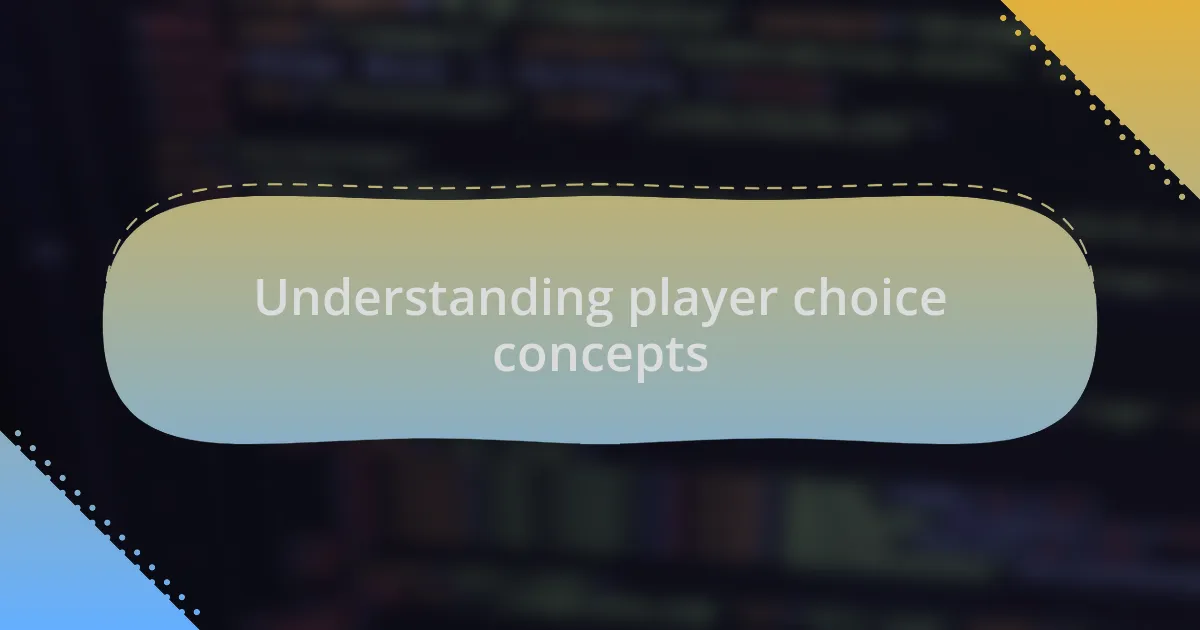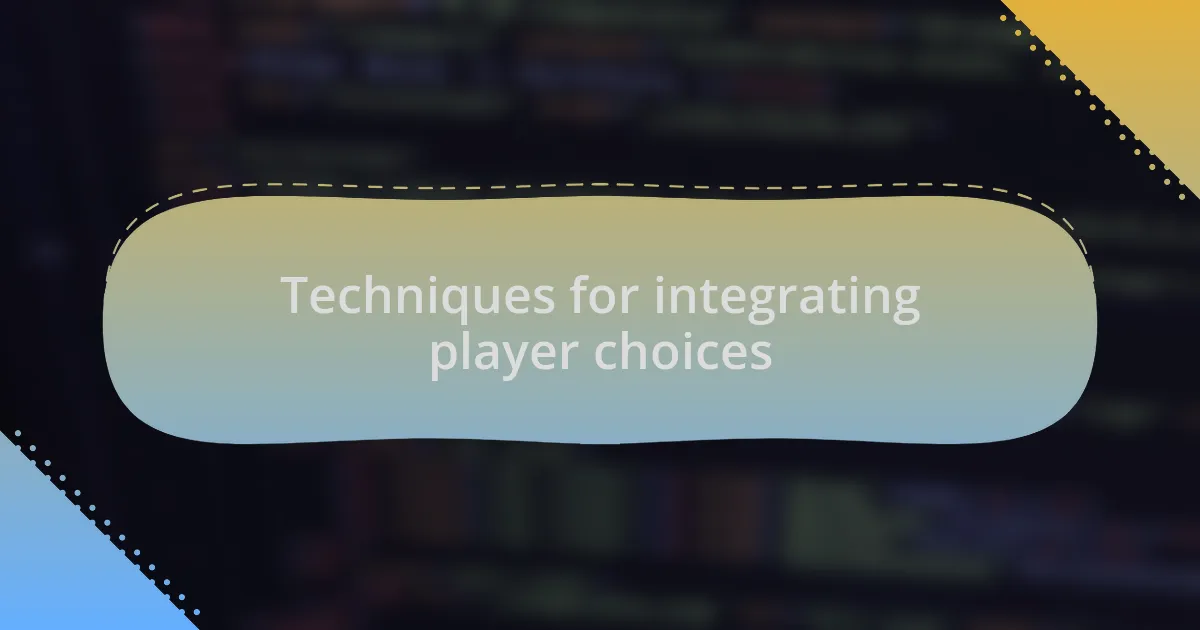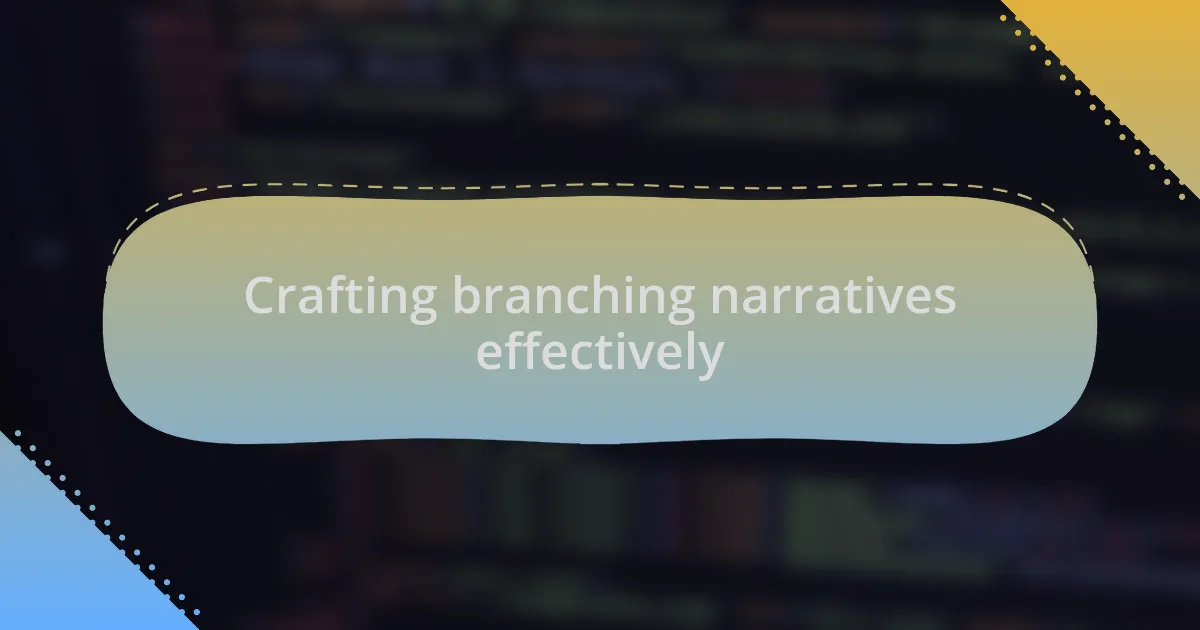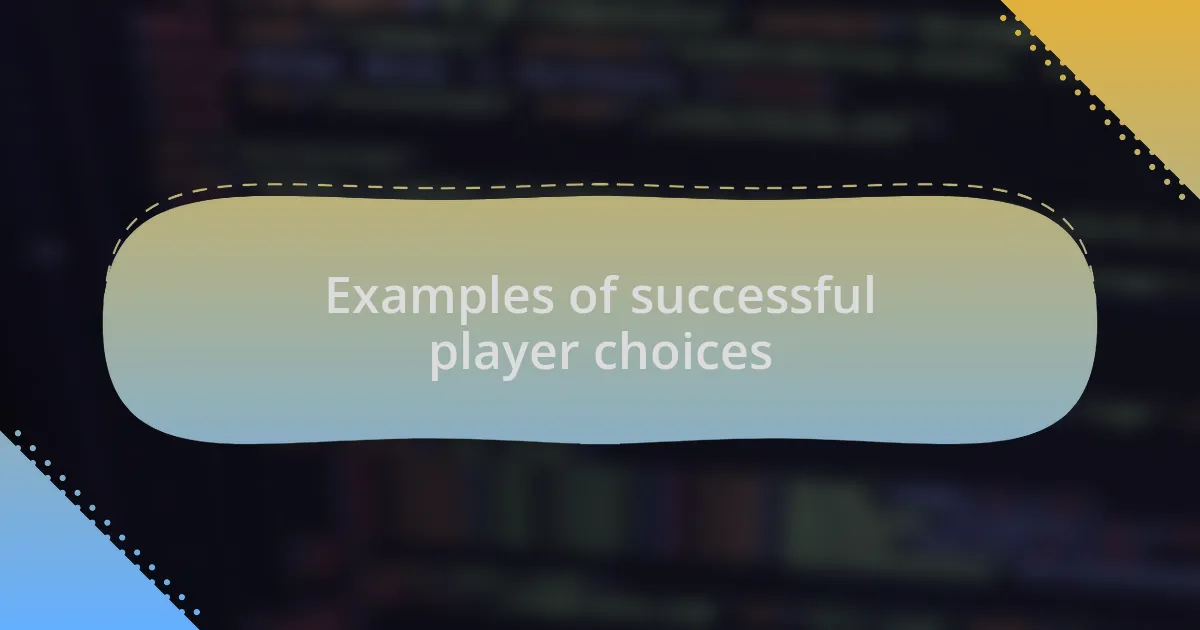Key takeaways:
- Player choice enhances narrative immersion, prompting players to reflect on their values and moral dilemmas.
- Integrating branching dialogue trees and visible choice outcomes creates a sense of ownership and emotional investment in the story.
- Effective branching narratives require careful pacing of choices and development of memorable characters that resonate with players’ real-life experiences.
- Feedback from players is crucial for refining storytelling and fostering a collaborative narrative experience.

Understanding player choice concepts
Understanding player choice is fundamental to creating engaging narratives in any game. I remember the first time I experienced a game where my decisions profoundly impacted the story’s direction. It hit me: choice isn’t just a mechanic; it’s a bridge between the player and the story, bringing immersion to a whole new level.
When I reflect on how player choices can often evoke strong emotions, I think about moments when I had to make a tough decision that altered the fate of characters I had grown to care for. It made me question what I valued more: my own moral compass or the happiness of fictional characters. Isn’t it fascinating how these dilemmas spark deep introspection, allowing players to see themselves in this digital world?
Moreover, the concept of branching narratives further amplifies this connection between players and their choices. I’ve seen how even subtle decisions can create ripple effects, leading to moments of joy or regret. I often wonder, how can we as developers harness this potential to craft stories that resonate long after the game is over? Engaging with this concept pushes us to explore the importance of player agency in storytelling.

Techniques for integrating player choices
To effectively integrate player choices into storytelling, I often employ branching dialogue trees that allow players to influence conversations meaningfully. When I first experimented with this technique in a project, I noticed that players expressed a sense of ownership over the story. It was exhilarating to see them discuss their choices based on how they felt about the characters, making every interaction feel personal.
Another method I use involves making choice outcomes visible throughout the game. For instance, in one of my earlier games, I implemented a system where players’ previous decisions would come back to affect them later in unexpected ways. I remember a player sharing how a decision they made early on haunted them in a crucial moment, elevating the emotional stakes. Isn’t it amazing how such echoes of choice enrich the player’s experience, transforming their journey into one that feels alive and reactive?
Finally, I find that offering choices that align with thematic elements deepens player engagement. In one narrative I wrote, I gave players a choice between acting out of revenge or forgiveness in a pivotal moment. I love how one player once told me that their choice reflected their own experiences with personal conflict. Isn’t it something special when a game can touch on real emotions, making players reflect on their own lives while navigating their avatar’s journey?

Crafting branching narratives effectively
Crafting effective branching narratives requires a delicate balance between choice and consequence. In my experience, weaving subtle clues into the storyline can enrich the player’s journey. I remember creating a character motivated by a past betrayal, and I embedded hints that hinted at their complex backstory. Players often remarked how discovering these layers made their decisions feel significant, as if they were piecing together a puzzle that shaped both the narrative and their character’s fate.
Another aspect I’ve found crucial is the pacing of choices. It’s vital for players to encounter decisions at key moments within the plot. When I designed a climactic scene where players had to choose whether to trust an ally or go solo, the tension was palpable. I noticed that players would often gasp when making their choice. That shared moment of suspense not only heightened their emotional investment but also encouraged conversations about alternate paths they could have taken. Does that shared tension not add another layer of excitement to the narrative experience?
Ultimately, I believe that creating memorable characters is central to crafting branching narratives. I once developed a protagonist who grappled with moral dilemmas that mirrored real-life struggles, like loyalty versus ambition. One player confided in me that their feelings toward this character felt personal, as if they were navigating their own conflicts through the gameplay. Isn’t it remarkable when a story allows players to explore not just the narrative world but their own identities through the decisions they make?

Utilizing feedback to enhance choices
Feedback serves as the pulse of player choice in storytelling. I recall a situation where I implemented a feedback mechanism that let players know how their choices impacted the world. After making a difficult decision, many shared their feelings about it on forums, expressing a sense of ownership over the narrative. Isn’t it captivating when players feel genuinely connected to their choices, transforming the game into a personal experience?
Incorporating player feedback requires active listening and adaptation. I remember modifying the dialogue options in an early prototype based on player responses during testing. Seeing them engage more deeply with the characters after I made those adjustments reaffirmed my belief that the narrative should evolve alongside the player’s journey. How often do we reflect on how our own experiences shape the stories we tell?
Moreover, I found it beneficial to create a space for players to express their thoughts and reactions. There was a moment when I gathered a group of testers to discuss their emotional responses to certain plot twists. The insights they shared not only sparked new ideas for future branches in the story but also made me realize how collaborative storytelling can deepen the player’s investment. Doesn’t hearing their voices not only validate their choices but also transform storytelling into a shared adventure?

Examples of successful player choices
When considering successful player choices, I find one standout example in the narrative of The Witcher 3: Wild Hunt. One choice I made was whether to help a character facing severe consequences for their actions. After agonizing over it, I chose to intervene, only to see the ripple effects of that decision echo throughout the story. Seeing previous allies change their attitudes and new conflicts arise was nothing short of exhilarating. How rewarding is it to know that a single choice can dramatically reshape a story’s landscape?
Another memorable moment came from my early days of game development, particularly with a branching storyline where players could choose to either betray or support a companion. During playtesting, several participants expressed guilt when they betrayed their ally, despite knowing it might lead to a better outcome for their character. This emotional weight was unexpected but profoundly impactful. Isn’t it fascinating how players can feel such deep remorse for a digital connection?
Finally, I remember developing a quest involving a moral dilemma where players had to choose between saving a village or pursuing a personal quest. Watching players grapple with this decision brought out rich discussions about values and priorities. Some chose to sacrifice personal gain for the greater good, while others prioritized their own narrative arc. This dynamic made me realize how player choice can not only enrich gameplay but also prompt introspection about our own life choices. Don’t we all have moments where we must weigh our personal desires against broader consequences?